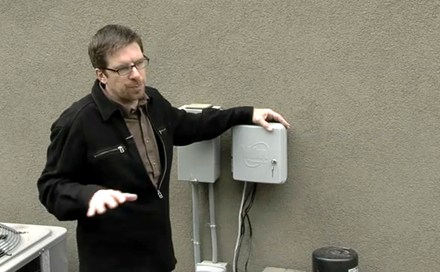Irrigation System with Weather Station
See how this irrigation system's weather station controls the amount of water used on the landscaping
A video transcript featuring Joseph Huettl, Huettl Landscape Architecture
For this project, for the irrigation, we used a combination of the multistream rotors, which are water efficient. We used drip systems in certain areas that were narrow or adjacent to the house, and then other areas we used conventional pop-up spray heads, where we had tight areas that would benefit from that. All of the automatic irrigation is tied to a smart controller. In this case it's a Weathermatic SmartLine.
Smart control featuresSmart controllers are the new thing now. They've been out for several years. They're starting to be required in some instances, and they program differently from a regular controller. On this one, you can have it on standard programing or you could also go to auto-adjust. On the auto-adjust feature, instead of programming in hours and minutes and days for the sprinklers to come on, you just designate in each zone the plant type, the soil type, the slope, and the type of irrigation you're using. And then the smart controller is tied into a weather station that determines the needs of those plants based on that type of irrigation and that type of slope and soil type based on the weather -- whether it's been rainy, and the amount of heat, evapo-transpiration rate and so on.
When we set up these smart controllers, we like to use the option of the standard programming initially so that we know that the controllers are coming on - initially when you first plant you might need it to come on every day or every other day. So initially, we'll set up a standard programming with the minutes and the days for the different stations to come on, but in parallel to that we also program in the soil types and the plant types and the irrigation types for the zones that, once things are a bit rooted in, then we can tie it into the automatic system that's based on the weather station and see if there are any hiccups involved.
Weather station optionsThen we'll take a look at the weather station. Part of this smart controller setup includes a weather station. It involves a rain sensor and temperature sensors, and this is wireless in this case, and it sends a signal back to the controller with the weather data that determines how the plants are watered. There are other options. Some of these smart controllers use a subscription service, where the information is gathered locally from several different weather stations and then it's sent via satellite to the controller. In those cases, you're paying yearly for a subscription. There may be some advantage to that with more points of monitoring the climate, but generally there are two ways to go with a smart controller: an onsite weather station or a subscription service.
Advantages of smart controlsThe main reason why people would use the smart controller would be for water savings and money savings. On a large site, it can save thousands of dollars a year and easily pay for itself. In addition to the homeowner reasons for saving water and saving money, many communities or jurisdictions are requiring a smart controller system to be used in new irrigation or new landscape installation. In addition to that, many water districts are providing financial incentives to homeowners to install such a system because it saves water in the long run.






